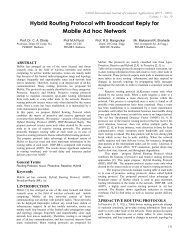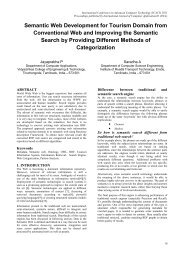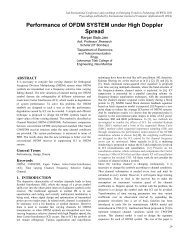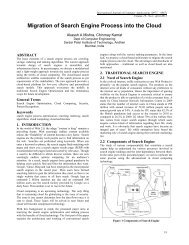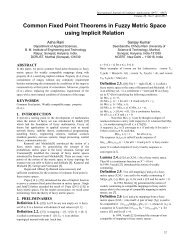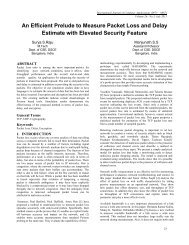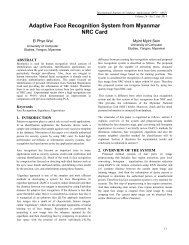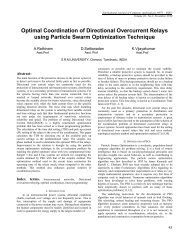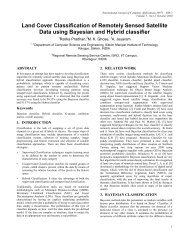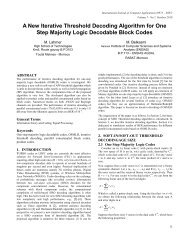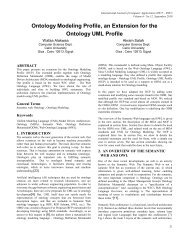A Novel Method of Mining Association Rule with Multilevel Concept ...
A Novel Method of Mining Association Rule with Multilevel Concept ...
A Novel Method of Mining Association Rule with Multilevel Concept ...
You also want an ePaper? Increase the reach of your titles
YUMPU automatically turns print PDFs into web optimized ePapers that Google loves.
International Conference on Advanced Computer Technology (ICACT) 2011<br />
Proceedings published by International Journal <strong>of</strong> Computer Applications® (IJCA)<br />
2. LITERATURE SURVEY<br />
Using a minimum support threshold to identify frequent patterns<br />
assumes that an ideal minimum support threshold exists for<br />
frequent patterns, and that a user can identify this threshold<br />
accurately. Assuming that an ideal minimum support exists, it is<br />
unclear how to find this threshold [18]. This is largely due to the<br />
fact that there is no universal standard to define the notion <strong>of</strong><br />
being frequent enough and interesting. In this case one user’s<br />
understanding <strong>of</strong> an ideal strength value may be different from<br />
another user’s.<br />
A data set contains items that appear frequently while other items<br />
rarely occur. For example, in a retail fruit business, fruits are<br />
frequently observed but occasionally bread is also observed.<br />
Some items are rare in nature or infrequently found in a data set.<br />
These items are called rare items [11]. If a single minimum<br />
support threshold is used and is set high, those association rules<br />
involving rare items will not be discovered. Use <strong>of</strong> a single and<br />
lower minimum support threshold, on the other hand, would<br />
result in too many uninteresting association rules. This is called<br />
the rare item problem defined by Mannila. Instead <strong>of</strong><br />
preprocessing the transaction records, using multiple minimum<br />
thresholds called minimum item supports (MISs) . Nonetheless, a<br />
user needs toprovide an MIS threshold for each item which is<br />
difficult. The common aim, however, was to <strong>of</strong>fset heuristics<br />
when setting up a minimum support threshold. In all these<br />
approaches, we see that state-<strong>of</strong>-the-art association rule mining<br />
has drifted from the original idea <strong>of</strong> mining frequent patterns<br />
alone to considering other patterns as well. Using a minimum<br />
support threshold alone cannot identify these patterns<br />
specifically.<br />
Brin [6] shows that association rules discovered using a support<br />
and confidence framework may not be correlated in statistics.<br />
These association rules show item sets co-occurring together,<br />
<strong>with</strong> no implications among them. Scheffer highlights that in<br />
many cases, users who are interested in finding items that cooccur<br />
together are also interested in finding items which are<br />
connected in reality. Having a minimum support threshold does<br />
not guarantee the discovery <strong>of</strong> interesting association rules, as<br />
such rules may need to be further processed and quantified for<br />
interestingness.<br />
The usage <strong>of</strong> leverage and lift are good alternatives in mining<br />
association rules <strong>with</strong>out relying on pruning a minimum support<br />
threshold. The authors in mined arbitrarily top k number <strong>of</strong> rules<br />
using lift, leverage, and confidence <strong>with</strong>out using a preset<br />
minimum support threshold. The use <strong>of</strong> leverage and lift is also<br />
fundamental in designing a new measure <strong>of</strong> interestingness.<br />
Among such work, authors in [13] considered lift as also one <strong>of</strong><br />
the 12 interesting criteria to generate interesting rules called an<br />
informative rule set. Authors in devised a conditional<br />
probability-like measure <strong>of</strong> interestingness based on lift (termed<br />
as dependence) called the Conditional Probability Increment<br />
Ratio (CPIR) and used this to discover required interesting rules<br />
accordingly. Apart from the use <strong>of</strong> lift, leverage, and its derived<br />
measure <strong>of</strong> interestingness, measures <strong>of</strong> interestingness that<br />
consider a deviation from independence have also been used. The<br />
authors in [3] used Pearson’s correlation coefficient to search for<br />
both positive and negative association rules that have a strong<br />
correlation. This search algorithm found the strongest correlated<br />
rules, followed by rules <strong>with</strong> moderate and small strength values.<br />
The generalized framework is used to discover association rules<br />
that have the properties <strong>of</strong> propositional logic, and a specific<br />
framework (Coherent <strong>Rule</strong>s <strong>Mining</strong> Framework) <strong>with</strong> a basic<br />
algorithm to generate coherent rules from a given data set. The<br />
discovery <strong>of</strong> coherent rules is important because through<br />
coherent rules, a complete set <strong>of</strong> interesting association rules that<br />
are also implicational according to propositional logic can be<br />
discovered.<br />
Multi-level association rules are used to find the preferences for<br />
items that are not covered by the single-level association rules<br />
due to the data sparseness. Instead <strong>of</strong> considering single attribute<br />
for the rules multiple attributes are considered for obtaining more<br />
specific rules.<br />
Problem Definition<br />
The coherent rules are identified for the domain and based on the<br />
support value as well as the logical equivalences according to<br />
propositional logic the association rules are filtered out. The rules<br />
obtained include item sets that are frequently and infrequently<br />
observed in a set <strong>of</strong> transaction records for a single level. Here<br />
the generalized framework is obtained. The generalized<br />
framework will not help in-depth decision making as the rules<br />
obtained will be high level. Though the rules are logically<br />
correct, some scenarios occur in which the support is equal for<br />
both the rules that are coherent and here no proper decision can<br />
be made.<br />
3. METHODOLOGY<br />
The steps involved in the development <strong>of</strong> multilevel<br />
propositional logic based knowledge discovery involve the<br />
following phases:<br />
‣ Data Preprocessing<br />
‣ Propositional Logic for Coherent <strong>Rule</strong> Generation<br />
‣ Multi-Level concept hierarchy<br />
‣ Performance measure on generated rules<br />
Data Preprocessing<br />
Data preprocessing is a major step in data mining where all the<br />
unnecessary data in the datasets will be removed. Based on the<br />
nature <strong>of</strong> datasets taken for the experiment the preprocessing<br />
process will take place. If the dataset contains mostly missing<br />
attributes then those should be supplied by taking the previous<br />
observations.<br />
Figure 1Logic Pattern Discovery-useless attributes<br />
Figure 2 Logic Pattern Discovery-duplicate animals list<br />
In this work mainly removing the duplicate records and useless<br />
attributes were performed. Figure 1 shows the logical pattern<br />
discovery for useless attributes. These are done to minimize the<br />
27



